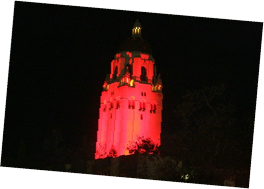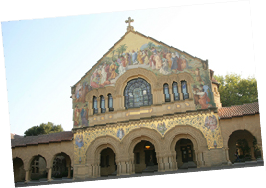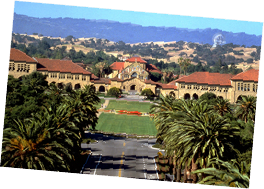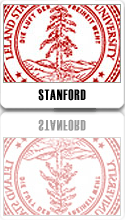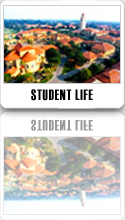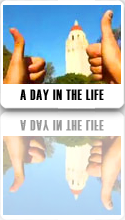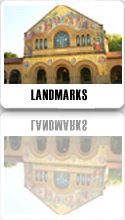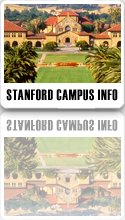
Hoover Tower
Hoover Tower, visible throughout the surrounding area, serves as a landmark of Stanford to faculty, students, alumni and the local community. Completed in 1941 to celebrate the university's 50th anniversary, the 285-foot structure offers superb views of Stanford and the Bay Area from its observation deck. Atop Hoover Tower is a carillon of 48 bells cast in Belgium. The largest bell is inscribed, 'For Pease Alone Do I Ring.'
Hoover Tower is part of the Hoover Institution on War, Revolution and Peace, a Stanford-affiliated public policy research center founded by Herbert Hoover, a member of the university's pioneer class of 1895 and the 31st president of the United States. Rooms on the ground floor of Hoover Tower contain exhibits of many items from President Hoover's career.
Hoover Tower's observation deck is open daily from 10am to 4:30pm and closed during finals and academic breaks.
Memorial Church
The spiritual home of the religious life on campus, nonsectarian Memorial Church also is the architectural centerpiece of the Main Quad and a landmark widely recognized as an emblem of the university.
Memorial Church's facade, decorated with colorful mosaics (there are over 20,000 shades of color in the tile), enlivens the Quad's stark beauty. The church's ornate interior boasts stained glass windows, intricate stonework, gold leaf decoration and redwood ceilings. Those fortunate enough to visit Memorial Church in the early morning may be treated to an impromptu concert by the university organist on one of the church's four organs.
The church, affectionately known as "MEMCHU" was built in the early 1900s by Jane Lathrop Stanford in memory of her husband, Leland Stanford Sr., who founded the university with his wife. Memorial Church is the site of numerous campus events, from choir concerts and lectures to religious and spiritual services. Since 1903, about 7,500 couples have been married in the church.
Palm Drive
Palm Drive, the mile-long, palm tree-lined entrance to campus, connects Stanford with the neighboring town of Palo Alto. Bike and walking paths and an arboretum border Palm Drive, and the street culminates at the Oval, a lawn at the front of campus where students often study or play volleyball and Frisbee. The view west down Palm Drive -- with palm trees framing Memorial Churcha and the foothills beyond -- is a classic Standford shot.
Main Quad
The expansive Main Quad conatains the university's first buildings, constructed between 1887 and 1891. With its palm trees and sandstone arcades, the distinctively Northern California style of the Inner Quad has a calming influence on passersby, and students frequently can be found studying in the shadows of its arches ,or sleeping on the edges of its sun-drenched planter islands.
The Stanford campus plan was designed by famed landscape architect Frederick Law Olmsted, who designed New York's Central Park. The university's 'Mission-style' architecture was strongly influenced by the Romanesque designs of H.H. Richardson. University architects Shepley, Rutan and Coolidge of Boston were young associates of the famous architect.
The Dish
A radio telescope commonly known as "The Dish" is the most prominent landmark in the foothills. Built in 1961, the 150-foot-diameter Dish, which SRI International operates and maintains and the US goverment owns, is still in use today to scan distant planets and galaxies.
SLAC
Since its founding in 1962, the Stanford Linear Accelerator Center (SLAC) has helped yield key discoveries in elementary particle physics, a study that provides insight into the fundamental copmosition of matter. The 426-acre facility, which includes a two-mile linear accelerator, is operated by the university for the US Department of Energy. Roughly 1,300 employees work at SLAC, and three Stanford physicists --
